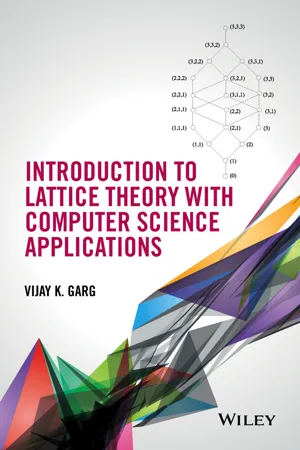
- English
- ePUB (mobile friendly)
- Available on iOS & Android
Introduction to Lattice Theory with Computer Science Applications
About this book
This book provides a uniform treatment of the theory and applications of lattice theory. The applications covered include tracking dependency in distributed systems, combinatorics, detecting global predicates in distributed systems, set families, and integer partitions. The book presents algorithmic proofs of theorems whenever possible. These proofs are written in the calculational style advocated by Dijkstra, with arguments explicitly spelled out step by step. The author's intent is for readers to learn not only the proofs, but the heuristics that guide said proofs.
Introduction to Lattice Theory with Computer Science Applications:
- Examines; posets, Dilworth's theorem, merging algorithms, lattices, lattice completion, morphisms, modular and distributive lattices, slicing, interval orders, tractable posets, lattice enumeration algorithms, and dimension theory
- Provides end of chapter exercises to help readers retain newfound knowledge on each subject
- Includes supplementary material at www.ece.utexas.edu/~garg
Introduction to Lattice Theory with Computer Science Applications is written for students of computer science, as well as practicing mathematicians.
Frequently asked questions
- Essential is ideal for learners and professionals who enjoy exploring a wide range of subjects. Access the Essential Library with 800,000+ trusted titles and best-sellers across business, personal growth, and the humanities. Includes unlimited reading time and Standard Read Aloud voice.
- Complete: Perfect for advanced learners and researchers needing full, unrestricted access. Unlock 1.4M+ books across hundreds of subjects, including academic and specialized titles. The Complete Plan also includes advanced features like Premium Read Aloud and Research Assistant.
Please note we cannot support devices running on iOS 13 and Android 7 or earlier. Learn more about using the app.
Information
Table of contents
- Cover
- Title Page
- Copyright
- Table of Contents
- Dedication
- List Of Figures
- Nomenclature
- Preface
- Chapter 1: Introduction
- Chapter 2: Representing Posets
- Chapter 3: Dilworth's Theorem
- Chapter 4: Merging Algorithms
- Chapter 5: Lattices
- Chapter 6: Lattice Completion
- Chapter 7: Morphisms
- Chapter 8: Modular Lattices
- Chapter 9: Distributive Lattices
- Chapter 10: Slicing
- Chapter 11: Applications of Slicing to Combinatorics
- Chapter 12: Interval Orders
- Chapter 13: Tractable posets
- Chapter 14: Enumeration Algorithms
- Chapter 15: Lattice of Maximal Antichains
- Chapter 16: Dimension Theory
- Chapter 17: Fixed Point Theory
- Bibliography
- Index
- End User License Agreement